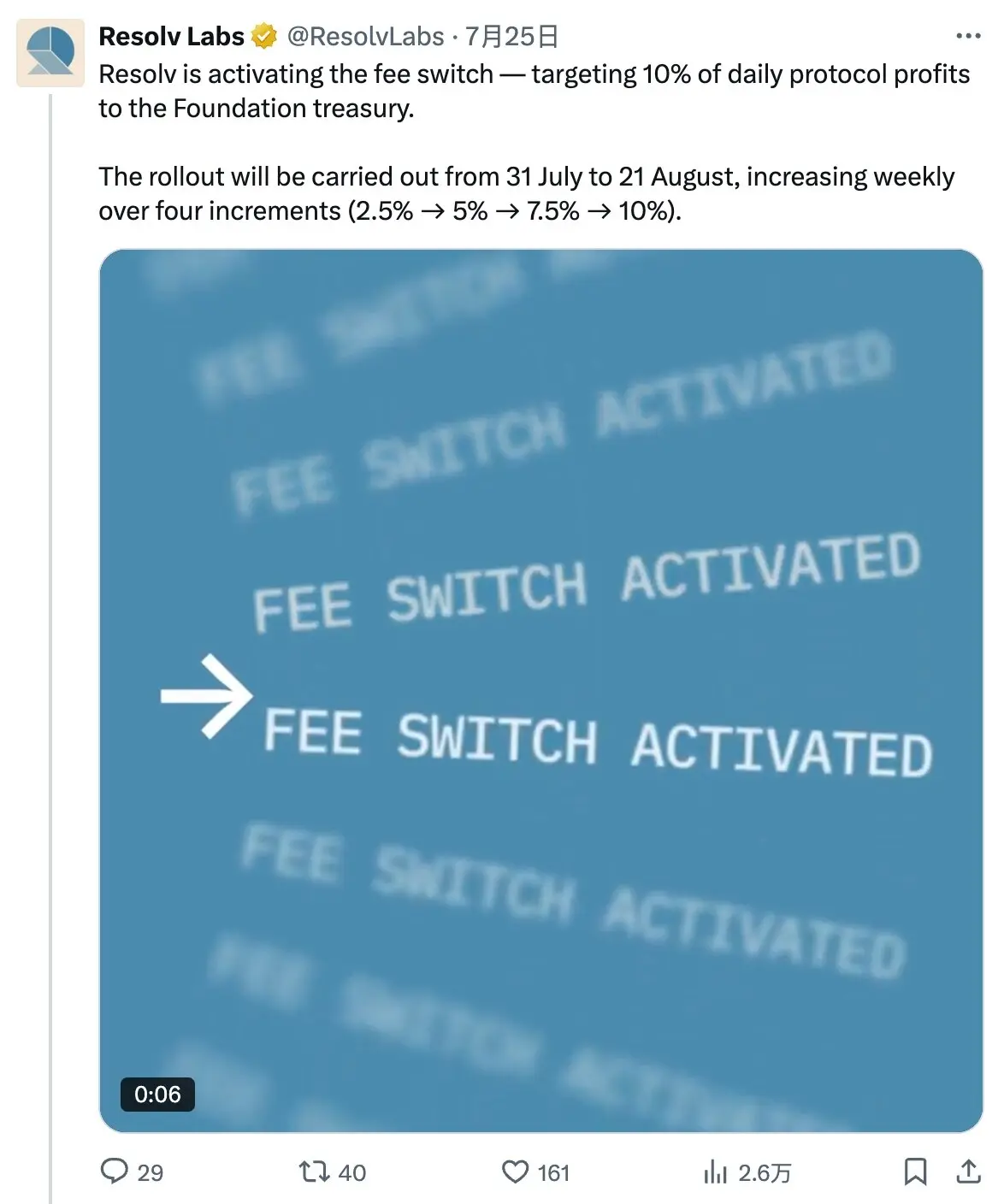The "fee switch" is activated, will the new stablecoin protocol RESOLV become the next ENA?
Original | Odaily Planet Daily
Author |
On July 25, Beijing time, Resolv, an interest-bearing stablecoin protocol, officially announced that it will gradually turn on the "fee switch", intending to transfer up to 10% of the daily protocol revenue to the foundation's treasury for long-term value creation and incentivize RESOLV staking users. Specifically, Resolv plans to gradually increase the percentage of revenue transferred (2.5% → 5% → 7.5% → 10%) per week over a four-week period from July 31 to August 21, culminating in a target of 10%.

The so-called "fee switch" is a common term for fee distribution in DeFi protocols, which is commonly understood as "a built-in contract function that determines whether the protocol allocates revenue to the native token", but different protocols have different specific execution models. Previously, well-known projects such as Uniswap and Ethena had also discussed the issue of "fee switches", but they were not activated due to community distribution disputes and doubts about the maturity of conditions.
In general, the "fee switch" generally means a direct benefit to the protocol's native token, as it will directly amplify the token's value capture ability; However, on the other hand, since the "fee switch" often transfers part of the income that originally belonged to protocol users to token holders, which will harm the interests of users to a certain extent, major protocols will always be hesitant about whether to turn on the "fee switch" - for example, in the Uniswap scenario, liquidity providers (LPs) could originally receive all 0.3% of the transaction fee income, but after the "fee switch" was turned on, they had to transfer part of the profits to UNI holders and LPs The interests of the people will be relatively damaged.
Resolv's positioning and considerations
Back to Resolv, similar to Ethena's USDe, the USR issued by Resolv is also an interest-bearing stablecoin collateralized by an equal amount of spot long and contract shorts, and its income mainly comes from "staking income from spot longs" and "funding rate income from contract shorts".
However, compared to Ethena, Resolv has also made some additional mechanism designs, such as introducing a risk rating mechanism through the insurance pool RLP, which enables USR to achieve a higher overcollateralization ratio. Another example is the access to liquid derivative tokens for a larger proportion, achieving higher spot staking income. Under Resolv's mechanism design, the protocol has achieved an annualized yield of approximately 9.5% since its inception, which is quite outstanding among emerging stablecoins.
At the end of May, Resolv officially launched its governance token RESOLV, and although Resolv has tried to empower RESOLV by "providing high staking income" and "accelerating the points accumulation rate of airdrops in the second quarter", RESOLV's performance after its launch is still not ideal. Perhaps it is precisely to boost the currency price that Resolv has set its sights on the "fee switch".
In the official announcement about turning on the "fee switch", Resolv mentioned that "the timing and architecture are ripe" - the protocol has achieved realistic, non-theoretical traction; The agreement has a clear value distribution framework; The protocol has shown resilience – hence the decision not to delay the launch of the "fee switch".

As mentioned earlier, Resolv plans to gradually increase the revenue transfer ratio over four weeks, eventually increasing to 10%. As for the specific use of this portion of revenue, Resolv's formulation is that it "will be used to expand the value Resolv provides to users and stakers", including: 1) supporting new integrations between DeFi, fintech and institutional venues; 2) funding ecosystem grants and product development; 3) Promote buybacks and other token-related initiatives. Resolv also mentioned the launch of a dedicated dashboard in the future to track revenue usage.
Resolv also made a rough assumption about the distribution of protocol revenue after the "fee switch" was turned on. Based on the current protocol's TVL of $500 million and an average yield of 10%, it is expected to achieve $50 million in annual revenue, and after the "fee switch" is turned on, $45 million will still flow directly to users through product revenue, and the protocol will retain $5 million for long-term value creation.
Is RESOLV more cost-effective than ENA?
In last week's article "Up Nearly 50% in a Week, Will ENA Be ETH's Biggest Beta?" ", we have analyzed the logic of ENA's recent strong rise; Later, Ethena launched a treasury reserve mechanism similar to a "micro-strategy" around ENA, which further boosted the price of ENA.
With the launch of ENA, more and more people have begun to set their sights on Resolv, an interest-bearing stablecoin project with a similar mechanism. So, is RESOLV really more cost-effective than ENA?
From the perspective of static figures, the current TVL of Ethena is US$7.781 billion, ENA's circulating market value (MC) is US$4.016 billion (MC/TVL ratio is 0.51), and the full circulation valuation (FDV) is US$9.48 billion (FDV/TVL ratio is 1.22); The current TVL of Resolv is $527 million, the circulating market value (MC) of RESOLV is $57.28 million (MC/TVL ratio of 0.108), and the full circulating valuation (FDV) is $205 million (FDV/TVL ratio of 0.39).
Judging from the comparison of MC/TVL and FDV/TVL alone, RESOLV is indeed better than ENA in terms of static cost performance. Although ENA currently has the blessing of buying from the treasury reserve strategy, considering that RESOLV will preemptively turn on the "fee switch", the prices of both sides are expected to receive some support in the short term.
However, objectively speaking, the current application scope and network effect of USR are far inferior to USDe, and Ethena also has a second line of business, USDtb, in addition to USDe, Resolv still has a big gap compared to Ethena in terms of protocol potential energy.
In addition, it is worth noting that Resolv's statement about the "fee switch" part of the revenue is "will be used to expand the value provided by Resolv to users and stakers", but it does not mention how much of the 10% of the revenue will go to RESOLV stakers, so it is difficult to speculate on the scale of RESOLV's new value capture after the "fee switch" is turned on.
Overall, considering that RESOLV's market capitalization is relatively low, the current RESOLV is a major alternative option after ENA's surge, but the long-term development expectations of the Resolv protocol itself still need to be evaluated, and the detailed revenue distribution plan after the "fee switch" is turned on needs to be further disclosed. Whether it's worth taking a position or not, you still need DYOR.
